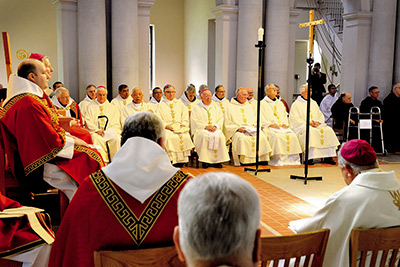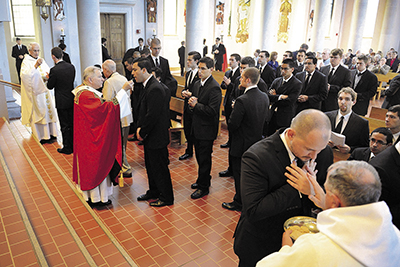By Peter Finney
COVINGTON, La., – The powerful oasis of prayer that is St. Joseph Abbey cannot be underestimated.
For 125 years, Benedictine monks have prayed, formed seminarians and directed retreats in south Louisiana. The 1,200 piney acres near Covington on which they pray and work – a pristine oasis amid suburban sprawl – are a tangible expression of the beauty of God’s creation, all at the service of prayer.

Bishop Emeritus Joseph Latino, seated in the first row at left, joined bishops from across the region for a Mass to celebrate the 125th anniversary of St. Joseph Seminary College Saturday, Oct. 4. (Photos courtesy of Franke Methe/Clarion Herald)
“The monastery has been a stable presence of prayer throughout all these years,” said Benedictine Abbot Justin Brown of St. Joseph Abbey. “The monks have been praying in southeast Louisiana for 125 years – every day, seven days a week, 365 days a year. That’s quite an amazing thing. Through that, we’ve offered not only to the seminary but to many other people a place for spiritual nourishment and retreat.”
The Benedictine community celebrated that rich, spiritual history Saturday, Oct. 4, with a Mass of Thanksgiving at 11 a.m. in the Abbey church. Bishop Emeritus Joseph Latino of the Diocese of Jackson, a 1963 graduate, joined principal celebrant Archbishop Gregory Aymond, a 1971 graduate of St. Joseph Seminary College for the Mass along with bishops from across Louisiana and Mississippi.
Other distinguished celebrants included three Benedictine abbots: Archabbot Justin DuVall of St. Meinrad Abbey, from which St. Joseph Abbey was established in 1889; Abbot Hector Sosa Paz of the Abbey of Jesus Christ Crucified in Esquipulas, Guatemala, established by St. Joseph Abbey in 1959; and Abbot Vincent Bataille, the president of the Swiss-American Congregation.
Prayer is the hallmark of any monastery, said Abbot Justin, who has served as abbot since 2001. The monks gather four times each day – at 6 a.m., 7 a.m., 5:30 p.m. and 7:15 p.m. – to pray the Divine Office, and they celebrate Mass at 11:15 a.m. Quite often the monks are joined by neighbors who immerse themselves in the monastery’s spiritual rhythms.
“We have regulars – both Catholics and Protestants,” Abbot Justin said. “The psalms are all from the Bible.”

St. Joseph seminarians, including Andrew Bowden of the Diocese of Jackson, second from last in line, receive Holy Communion during the Mass. The seminary college has had record classes in the past couple of years.
St. Benedict, who lived in the sixth century, called monks to do two things, Abbot Justin said – “to pray and to work within a community.”
“Prayer is central to our lives and the most important thing that we do,” he said. “But then, so is our work, and the work can take on many different possibilities.”
Preparing seminarians
The abbey’s primary work is the operation St. Joseph Seminary College, which was the reason the monastery was established in 1889 in a small town near Ponchatoula. Archbishop Francis Janssens asked the Benedictines to establish a monastery and seminary so that native clergy could be raised up. All seminarians from the Diocese of Jackson train at St. Joseph. Three of the nine current seminarians are there now.
The monastery moved to its current site in 1902, and following a 1907 fire, a large brick and steel building was constructed in 1908. The abbey church was dedicated in 1932, the same year that Abbot Columban Thuis became abbot. Abbot Columban served for 25 years, followed by Abbot David Melancon from 1957-82. Abbot Patrick Regan was elected in 1982 and served through 2001.
From its establishment, the abbey conducted a six-year program of seminary studies that included four years of high school and the first two years of college. After changes brought about by Vatican II, it converted to a four-year college program in 1964.
The K.C. Abbey Youth Camp opened on the abbey grounds in 1960, and the Abbey Christian Life Center opened for retreats in 1965.
Besides operating the seminary in conjunction with the Archdiocese of New Orleans, the abbey offers retreats, provides priests for parish ministry, operates a Pennies for Bread bakery, makes soap and hand-crafts simple cypress caskets. The abbey also has a cemetery available to the general public.
“The monastic life is a very simple life together,” Abbot Justin said. “The emphasis is on ‘together’ in the community. Unlike other religious, we take a unique vow of ‘stability of place.’ We stay and live within this community and this monastery all our lives. Each monastery is a family, and that is very much our charism.”
The connection to the surrounding community also is important.
“What I hear repeatedly from people is a sense of peace they feel when they cross over the bridge above the Bogue Falaya River, and come onto the abbey property,” Abbot Justin said. “Maybe it’s leaving a very busy, hectic world and coming to a place where the pace appears to be slower.”
Other festivities for the 125th anniversary include the Deo Gratias gala Nov. 1 in Covington; a Schola Cantorum Recital/Lecture by Benedictine Father Aelred Kavanaugh, music director Colby McCurdy and Benedictine Father Seán Duggan Nov. 9 at 3 p.m. in the abbey church; Music da Camera Nov. 30 at 3 p.m. in the abbey church; and closing vespers Jan. 28, 2015.
(Peter Finney is the editor of the Clarion Herald, the newspaper for the Archdiocese of New Orleans. Maureen Smith also contributed to this report.)
